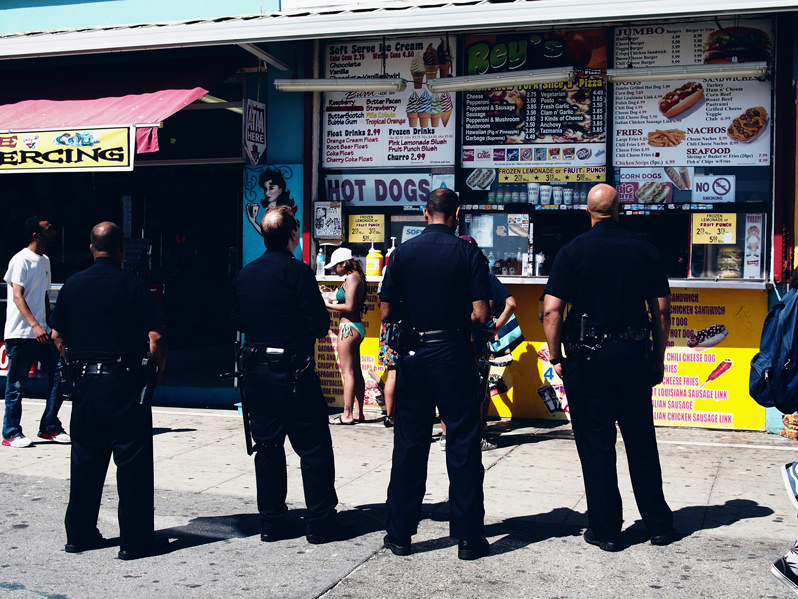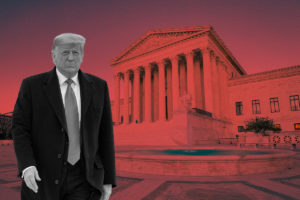Life in the Poorest Parts of America Is Not All ‘Urban Carnage’
A new book about the conflict between police and residents in South Los Angeles paints a much more humane, complex picture of poverty than President Trump does. Los Angeles police officers. (Edward Conde / CC BY-NC-ND 2.0)
Los Angeles police officers. (Edward Conde / CC BY-NC-ND 2.0)
“Blind to Injustice: How I Learned to See From Eight Years on the Streets With the LAPD and the People”
A book by Wellford (Buzz) Wilms
Retired UCLA professor Wellford (Buzz) Wilms’ forthcoming book exploring the conflict between police and residents in South Los Angeles reveals the multilayered complexity of the poorest parts of urban America. In “Blind to Injustice: How I Learned to See From Eight Years on the Streets With the LAPD and the People,” Wilms describes in admirable detail streets of tragedy, gang violence and occasional hope—contrary to President Donald Trump’s rabble-rousing description of such regions as “urban carnage.”
I worked in those neighborhoods for many years as a reporter. I know some of the people in his book. I had experience with the Los Angeles Police Department, from chiefs to patrol officers, and with community people who fought against the LAPD’s oppressive behavior.
Wilms describes the cops’ resistance to change. But, like me, he found police officers who mixed their toughness with compassion in a police department where minorities make up the majority of officers. The LAPD demographically reflects the city.
He also sees what I had seen—residents of South L.A. trying hard to save and improve their neighborhoods against great odds. He puts it together in a well-written book. I recommend “Blind to Injustice” to anyone concerned about solving one of the nation’s great social problems.
Wilms taught in the UCLA education department for 40 years and “gravitated toward more complex social issues that were not well understood.” He focused on the Los Angeles Police Department after the passage of President Bill Clinton’s 1994 crime bill. The destructive, get-tough legislation saddled the country with inhumanely long prison sentences, much of them handed out to blacks and Latinos for drug offenses. The sentences’ main accomplishment was to spur a boom in prison construction. To show he had a liberal heart, Clinton also embraced something called community policing. Basically, it envisioned cops modifying their practice of stopping and frisking every black and Latino, particularly males. Instead, police officers would bond with neighborhoods and their residents. Together they would vanquish crime.
That feature, not yet accomplished, attracted Wilms, and he and his team researched the LAPD.
“It was not at all what I expected,” he wrote. “Antagonism toward the police ran deeper than I had ever imagined, especially in African-American neighborhoods, and each new police shooting gave new life to memories of the past. I discovered how nightmarish memories of police brutality are tightly wound around racism that especially for blacks goes back hundreds of years.
“In truth, I had been blind to the importance of race for most of my life. I knew that deep down I harbored unconscious racist feelings that were too humiliating to face because they didn’t square with my image of myself. Suddenly I found myself face to face with my own bigotry that I could not escape.”
Wilms enjoyed hanging out with the police in action situations. He wrote of an experience he uses for the opening of his book: “I climb into the back seat of the brand-new Los Angeles Police Department Astar helicopter and buckle myself in right behind Mike Rodriguez, the tactical flight officer. The pilot, Jack Shonley, fires up the engine.” Looking for robbery suspects, “Jack sets up the helicopter in a tight counterclockwise orbit just 300 feet above the ground. The g-forces are pulling at me hard. …It’s a tremendous rush.”
After a time, however, Wilms saw he wasn’t getting the whole picture. “My initial view of South Los Angeles was from the front seat of a black and white, which is a poor way to learn about people in any city because you get only part of the picture and a jaded one at that,” he wrote. “My first impression of South L.A. was of desolation. … But when I began working in South L.A. … my impressions began to change. For all of its hardscrabble and dangerous conditions, thousands of people call South L.A. home. … When you look closely enough, you see compassion and the human spirit that are everywhere.”
Wilms offers no clear-cut solutions. But he finds hope working with men and women reaching out to gang members. He tells the story of Kevin Orange, a former gang member, one of a number of such young men who work in the schools, the parks, in the streets and other places as gang interventionists. When they see violence approaching, they intervene to stop it.
He had been shot eight times “leaving the cemetery where we’d buried one of my best friends … and I made a promise to find a purpose for my life on this earth.” Kevin told Wilms that “one night we were holding a candlelight vigil when some guys came in and shot up the place killing my twin brother Keith and my baby cousin.”
The efforts of such gang workers was hampered when department brass took control of much of the community policing, imposing a top-down military style that ran counter to the original vision of the plan. Public school bureaucrats often were of no help. Wilms joined with some residents in a smaller group, and they met frequently. Kevin Orange, now known as Twin, being the surviving brother, asked the group for help in going into the schools to meet with gang members. Wilms took it up to the school superintendent. Permission was not granted. “School opened, kids were jumped into gangs, and life went along as usual in South L.A.,” Wilms wrote.
These young men—working from the grassroots, never giving up—may lessen (but not end) the cycles of gang violence and hopelessness. Police officers should support their efforts. Our economic system, rigged to favor those at the top, had better make way for those in the middle and the bottom.
It sounds impossible, but Wilms seems somewhat encouraged by stories such of that of gang interventionist Twin, who was still on the job as the book ends, working out of an office in a South L.A. charter school. “Maybe I’m making a difference,” he told Wilms.
Under the best of circumstances, the work is slow—too slow, complicated and sensible for the impatient, shallow President Trump. After embracing stop-and-frisk and other extreme measures during his campaign, Trump now reduces vast stretches of America to a simplistic phrase, “urban carnage.” How mean-spirited and narrow that sounds compared to the work and goals of African-Americans and Latinos laboring to save their neighborhoods.
Independent journalism is under threat and overshadowed by heavily funded mainstream media.
You can help level the playing field. Become a member.
Your tax-deductible contribution keeps us digging beneath the headlines to give you thought-provoking, investigative reporting and analysis that unearths what's really happening- without compromise.
Give today to support our courageous, independent journalists.






You need to be a supporter to comment.
There are currently no responses to this article.
Be the first to respond.